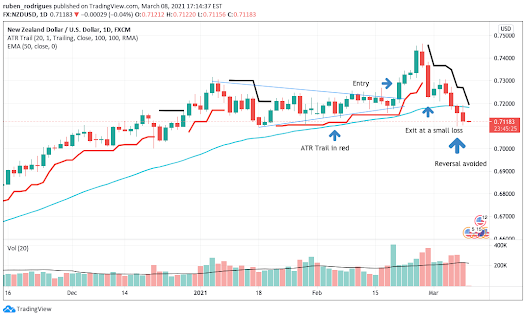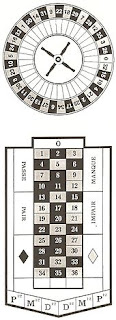Keep the Best and Leave the Rest
Price action, chart patterns, candlestick patterns, buy-signals ... these are, without a shadow of a doubt, the most seductive subjects for beginner traders. These are fantastic and widely used click baits, no doubt. Important subjects, hands down.
3. Small win: $MGM
The philosophy of this blog is not to share click bait friendly content though, but to provide you with sober, but top notch content. Content other similar pages won't be sharing as easily, or at least for free. Content that will bring you closer to level up from a gambler to a trader.
For the current message, I've chosen a topic that distinctively helped me crossing the gambler-trader bridge: TRADE MANAGEMENT.
Just like any other enthusiast there was a point in my journey where I was already hands on and quite fluent on chart analysis, pattern recognition and reading the story those information-rich lines and candles are trying to tell.
This moment felt like enlightenment had reach me. How cool was that! I could see the logic behind price action. I could detect hedge funds movements, their traps, identify the trend, identify the forces behind the price, the clash of emotions forming it ... how fucking cool, right?
Well! Of course It didn't take long to have my ego (and trading account) slapped in the face once again by another set of questions.
Eventually I'll be writing about price action principles and pattern probabilities but let me share this important spoiler already: Just like the pattern identified by the Casino in the roulette as identified in my last post, a good strategy based on sound entry triggers will most often have success odds resonating with the 51,4% roulette odds. This means that by the time you too can also read the story the charts are telling, you will be posed with another set of insecurities. Now, I'll tell you the ones floating in my mind at that stage, with some scenarios that would prompt them:
I'm at a 10 pct profit on $TSLA. At this stage do I take profit or do I let my trade open?
a) In case I took my profit, how am I going to feel like if I see the price rallying afterwards?
b) What if, instead of taking profit I hold my position and see the price retracing to breakeven or even to a loss?
Or other more mature trading question:
I'm at a 10pct profit on $TSLA, in line with most strategies, mine has a winning rate of 52pct. What if every time I lose, I lose 10pct of my position equity and every time I win, I win 5 pct of my position equity?
There are many ramifications to these questions, questions raised by other important topics such as risk management.
In my journey these questions became ostensible just like this: one month I was closing a lot of winning trades - I felt like the God of trading haha. Just to give them back in a couple of trading days the month afterwards (even with a stop loss in place).
Let me lay down the principles of the solution I found for these problems:
1. A trader is always unsatisfied. When a trader wins, the trader is unsatisfied because maybe he could have won more, when a trader loses, he is unsatisfied because he lost. This is unavoidable but can and should be mitigated.
2. No matter how good your strategy is, you'll always going to have a significant percentage of losers (just like 48,6pct example with the roulette). The losers are just the costs of doing business, just like any other business. Our job as traders is to keep them small.
3. Most important principle, and I reckon you can already agree with me on this one:
EVERY TRADE HAS 5 POSSIBLE OUTCOMES:
1. A BIG WIN
2. A SMALL WIN
3. A BREAKEVEN
4. A SMALL LOSS
5. A BIG LOSS
Picking up where I left on the previous post, one of the major hacks in my system aimed at setting the odds in my favor is to remove outcome 5 from the equation.
How? KEEP THE BEST AND LEAVE THE REST. Cut losers and rider winners. This requires a lot of discipline I warn you, but I'll get to that later.
Luckily, Trading View has a lot of useful tools and I ended up finding the one, among a lot of equally suitable options, that best serves my purposes: the ATR trail stop loss. I'll leave the details for other post, for now let's keep it like this: this is volatility based indicator that measures the average candle size over a determined period. After due backtesting I found out that once the 1 ATR trail is broken, there are good odds for a retracement/consolidation/reversal, moment when my money becomes better invest elsewhere. Yet again, I'll leave the details for another post, since this single subtopic and the way I apply it, is worth a lot more ink.
The concept I want to come across with is that this method serves me well in that it keeps big losses away from my records and allows big winners to sprout, grow, occupy one of the 30 available seats in my portfolio, pay for the small losses and leave a profit afterwards.
Since one image is worth more than a a thousand words, these are how my trade outcomes look like:
1. Small Loss: $NZDUSD
2. Breakeven: $PLTR
4. Big win: $TSLA
5. BIG LOSS: NOPE! NO DAMN BIG LOSS! NOT FOR ME SORRY!
Easy right? Also not, unfortunately. For very intriguing reasons actually! I encourage you to discover them by yourself. I'll leave you a couple of hints though. Average small loss trade length is 5-10 days and you can be sitting on big winners for 100 days sometimes. It follows that the losses pop up the earliest, then the breakevens, then the small wins and only then the big wins. It takes ... I wouldn't say guts ... I'd say, lack of emotions, discipline, trust in your edge to see the small losses piling on record, while your profitable positions are still open. All I can tell you is that it's worth taking them and waiting.
Happy Monday!
Cheers,
RR


Comments
Post a Comment